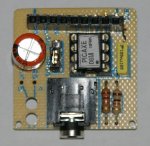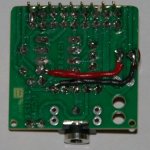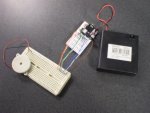I wanted a 08m in a base style sort of like the arduino's and their shield system. I use the 08M in so many small temporary projects that I got tired of prototyping the basic picaxe core. All 8 pins are brought up through the female header sockets. All the pins are on 0.1" spacing so generic protoboards stack right on it. The power can be brought down from the add-on board or provided by a battery pack. The serout pin is switched. This is my first successful toner transfer board so I'm a little excited about that. I used toner for the silk screen too.(Click for a bigger pic)





